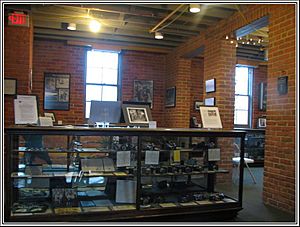Argus Museum facts for kids

A Gallery in the Argus Museum
|
|
| Established | 1987 |
|---|---|
| Location | Ann Arbor, Michigan |
The Argus Museum is a cool place in Ann Arbor, Michigan. It's on the second floor of a building at 525 West William. This museum shows off cameras and other items made by the Argus camera company.
It also shares stories about the company and the people who worked there. The museum is inside the Argus I Building. This building was once a factory where Argus products were made.
The museum's main goal is to collect and keep Argus Camera products safe. This includes items from when the company had different names. They also gather books and facts about the company and its workers. The museum researches these products and the people who made them. They want to make sure these collections are available for everyone to learn from. They also display items for people to see. This helps everyone learn about and enjoy the history of Argus.
Contents
Discovering the Argus Museum
The Argus Museum opened in 1987. It started with a special collection from Don Wallace. The museum has many rare cameras. These include giant models of the 75, A4, C3, and C4 cameras. These big models were used at trade shows.
You can also see experimental Model 12 cameras. Each one has a different kind of lens that folds up. There are also Model A cameras in many colors. These are favorites for collectors. You can see different versions of the Model C3 camera. People often called it "The Brick." Over two million of these cameras were sold!
The museum also displays items from Argus employees. These include papers about profit sharing. You can see employee ID badges too. There are also items from the many sports and activities Argus sponsored.
What's in the Collection?
The museum shows products made under all the company's names. These include International Radio Corporation and Argus Camera Incorporated. You can see many cameras, projectors, and viewers. They also have light meters and other camera accessories. Darkroom equipment from throughout the company's history is also on display.
Argus and the Wars
The museum tells stories about Argus's help in World War II and the Korean War. They show military items like sighting devices, prisms, and lenses. One cool item is an M72 Telescope. This telescope was used in Sherman Tanks. There's also an M18 sight. This was used with Britain's 57mm anti-tank gun, called the Britain Six-Pounder.
The Argus Archives
The museum has a huge collection of old photos and papers. These include instruction booklets and advertisements. There are also letters and manuals. But the best source of information might be the "Argus Eyes." This was the company's newsletter.
The newsletter had articles about government contracts and new products. But mostly, it shared personal news about employees. This included births, marriages, and retirements. It also mentioned soldiers returning from war. Social events, vacation stories, and funny daily life stories were often featured.
The Argus I Building is a great place for art. The museum hosts photography shows. It features artists from the local area. They especially like artists who use film to create images. The museum also holds meetings and book signings. They even host a Fall Conference for the Argus Collector Group (ACG).
History of the Argus I Building
- The building started as a wooden structure around 1866.
- It was first a shop for making cabinets.
- Then it became a furniture factory.
- A four-story brick building was built in 1879.
- In 1881, the old wooden building was covered with brick.
- It was then connected to the brick building by a new brick section.
- The International Radio Company bought the building in 1931. This company later became Argus Camera Incorporated.
- More parts were added between 1940 and 1951. This was to handle more business, especially military orders.
- In 1963, the University of Michigan became the owner.
- First Martin Corporation and O’Neal Construction bought the building in 1983.
- After fixing it up, they reopened the building in 1987.


